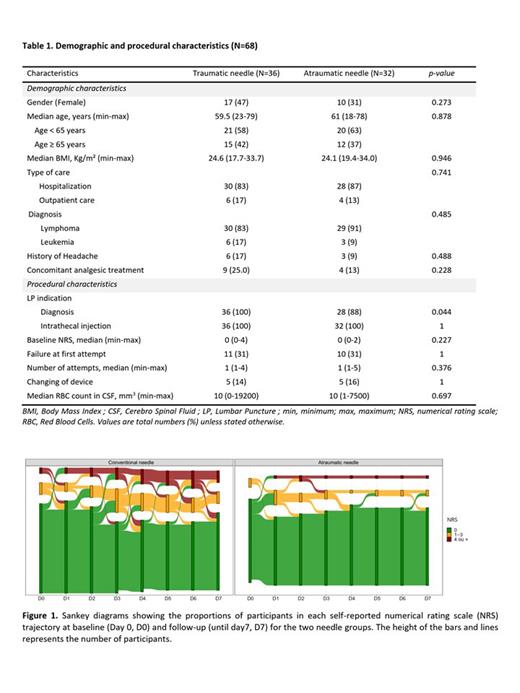Introduction - Postdural-puncture headache (PDPH) is the most common complication after lumbar puncture, probably due to leakage of cerebrospinal fluid (CSF) from the dural defect into the epidural space. Most cases of PDPH occur within 8 days of a lumbar puncture and may be associated with other symptoms, such as photophobia, nausea or neurological complications. In this context, PDPH is a debilitating condition that significantly impacts quality of life. While several risk factors have been proposed to participate in PDPH etiology, no preventive or therapeutic measures have robustly proven their efficacity . Among PDPH-related risk factors, needle tip shape has been shown to influence the incidence of PDPH, especially in the context of diagnostic LP. The purpose of this study was to assess the incidence of PDPH using conventional (cutting-type) or atraumatic (pencil-point) spinal needles in hematological patients.
Methods -This was a randomized, double-blind study of 68 adult patients scheduled for a diagnostic and/or therapeutic lumbar puncture (LP) (SPPLAASH study, NCT03126045). Subjects were randomly assigned to receive one of two needles : 22-gauge cutting (n=36) and 26-gauge atraumatic (n=32). LP and CSF collection were performed in accordance with standardized procedures. The main outcome was the occurrence of severe headache (≥4 out of 10 on the numerical rating scale (NRS)) as measured by interviews for 8 days after LP, repeated until headache resolution. Secondary outcomes included maximum intensity and duration of PDPH as well as procedural failure.
Results - The median age at the time of LP was 60 years (Q1-Q3, 46-70) and 40% of patients were women. Demographic and procedural characteristics are summarized in Table 1. No significant difference was statistically observed between the two treatment groups, except for LP indication. The overall rate of severe PDPH was 19.7% (95% CI - 10.9-31.3). Interestingly, the incidence of severe PDPH was statistically reduced from 31.3% (95% CI - 16.9-49.3) in the conventional needle group to 6.5% (95% CI - 0.8-21.4) in the atraumatic group (p=0.011). High body mass index (OR 0.72, 95% - CI 0.57-0.91) and male sex (OR 0.29, 95% CI 0.08-1) were factors associated with a lower risk of PDPH. Means of maximum intensity of PDHP at 8 days were estimated to be 2.3 (sd 3.1) in the conventional needle group and 0.7 (sd 1.31) in the atraumatic group, with a statistically difference when considering median intensities (p=0.032) and number of days with NRS ≥4 (p=0.030). We used Sankey flow diagram to map the trajectories of PDPH intensities during the 8-day follow-up (Figure 1). First attempt LP success, failure rate, mean number of attempts, and the frequency of analgesic prescritions did not statistically differ between the two needle groups.
Conclusion - Lumbar puncture is an essential and common procedure in hematologic clinical care and research. Our data indicate that atraumatic needles were associated with a decrease in the incidence of severe PDPH as well as in the duration of PDPH event. Moreover, the use of atraumatic needle was safe and feasible. Given that PDPH has a major impact on quality-of-life already altered by hematological treatments, and that headache might be caused by a differential diagnosis (e.g. cerebral sinus venous thrombosis due to Asparaginase in acute lymphoblastic leukemia), the use of atraumatic needles should be encouraged in this population, which often benefits from multiple LP.
Disclosures
Guillermin:Pfizer: Consultancy.


This feature is available to Subscribers Only
Sign In or Create an Account Close Modal